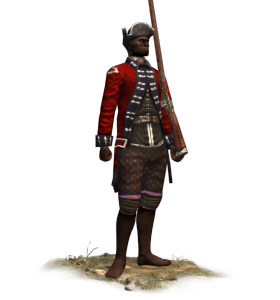Difference between revisions of "African Native Infantry (ETW Unit)"
(→Overview) |
|||
| Line 1: | Line 1: | ||
{{Unit|image=[[Image:Africannativeinfantry.png]]|Class=Line Infantry|Men=160|Weaponry=Muskets|Minimum Building Requirement=Barracks|Region=North Africa|Recruitment Cost=780|Upkeep Cost=190|Technology Needed=None}} | {{Unit|image=[[Image:Africannativeinfantry.png]]|Class=Line Infantry|Men=160|Weaponry=Muskets|Minimum Building Requirement=Barracks|Region=North Africa|Recruitment Cost=780|Upkeep Cost=190|Technology Needed=None}} | ||
| − | == | + | ==Game Description== |
“Marching regiments” or “line battalions” make up the majority of units in European-style armies. They are so called because they form the line of battle, not because they always deploy in lines. Indeed, over time the capabilities of line infantry should improve as new tactics, drill and weaponry are developed. | “Marching regiments” or “line battalions” make up the majority of units in European-style armies. They are so called because they form the line of battle, not because they always deploy in lines. Indeed, over time the capabilities of line infantry should improve as new tactics, drill and weaponry are developed. | ||
| Line 9: | Line 9: | ||
Historically, in many armies colonels received a fee to raise regiments, which remained their personal property and commands. They jealously guarded their rights to appoint friends, relatives and hangers-on as regimental officers. This contractor system, however, allowed unscrupulous officers to make handsome profits by pocketing the pay of non-existent soldiers. The better colonels did take a pride in their regiments, spending their own fortunes on good uniforms and weapons. The capabilities of a “standard” line infantry unit therefore varied between nations and over time. It wasn’t until the 1760s that anything approaching uniformity of drill, equipment and regulations became the norm. | Historically, in many armies colonels received a fee to raise regiments, which remained their personal property and commands. They jealously guarded their rights to appoint friends, relatives and hangers-on as regimental officers. This contractor system, however, allowed unscrupulous officers to make handsome profits by pocketing the pay of non-existent soldiers. The better colonels did take a pride in their regiments, spending their own fortunes on good uniforms and weapons. The capabilities of a “standard” line infantry unit therefore varied between nations and over time. It wasn’t until the 1760s that anything approaching uniformity of drill, equipment and regulations became the norm. | ||
| − | Line infantry regiments remained unchanged throughout the period, and their organisational pattern still forms the basis of modern military units. | + | Line infantry regiments remained unchanged throughout the period, and their organisational pattern still forms the basis of modern military units. |
| + | |||
| + | ==Overview== | ||
| + | |||
| + | These units are essentially poorer-quality line infantry trainable only in North Africa. Good substitutes for regular line infantry if none are available nearby. | ||
| + | |||
==Factions== | ==Factions== | ||
*[[Image:Britain_flag.jpg|25px]] [[Great Britain (ETW Faction)|Great Britain]] | *[[Image:Britain_flag.jpg|25px]] [[Great Britain (ETW Faction)|Great Britain]] | ||
Revision as of 22:03, 11 September 2011
Game Description
“Marching regiments” or “line battalions” make up the majority of units in European-style armies. They are so called because they form the line of battle, not because they always deploy in lines. Indeed, over time the capabilities of line infantry should improve as new tactics, drill and weaponry are developed.
These soldiers carry muzzle-loading, smoothbore muskets firing lead balls as wide as a man’s thumb. These are inaccurate weapons, effective only over 200 paces or so and when fired in massed volleys. The ability to fire and reload with machine-like regularity with shot and bullet flying and comrades falling all around is what wins battles.
Historically, in many armies colonels received a fee to raise regiments, which remained their personal property and commands. They jealously guarded their rights to appoint friends, relatives and hangers-on as regimental officers. This contractor system, however, allowed unscrupulous officers to make handsome profits by pocketing the pay of non-existent soldiers. The better colonels did take a pride in their regiments, spending their own fortunes on good uniforms and weapons. The capabilities of a “standard” line infantry unit therefore varied between nations and over time. It wasn’t until the 1760s that anything approaching uniformity of drill, equipment and regulations became the norm.
Line infantry regiments remained unchanged throughout the period, and their organisational pattern still forms the basis of modern military units.
Overview
These units are essentially poorer-quality line infantry trainable only in North Africa. Good substitutes for regular line infantry if none are available nearby.
